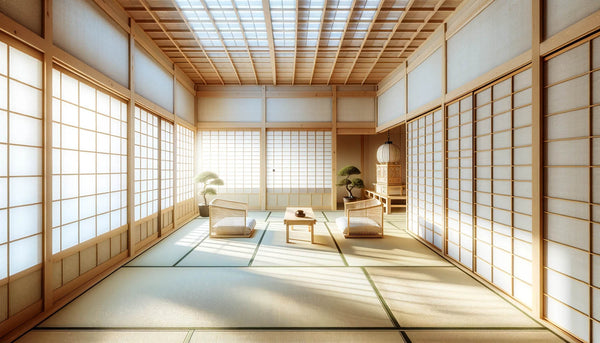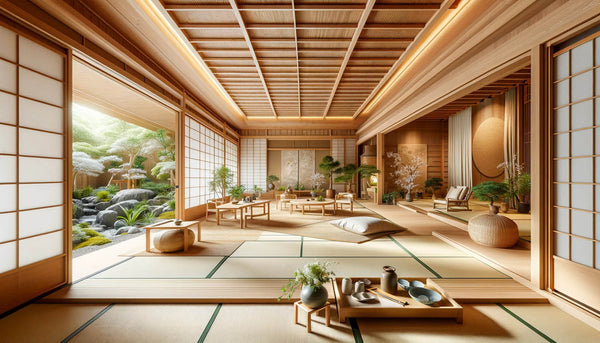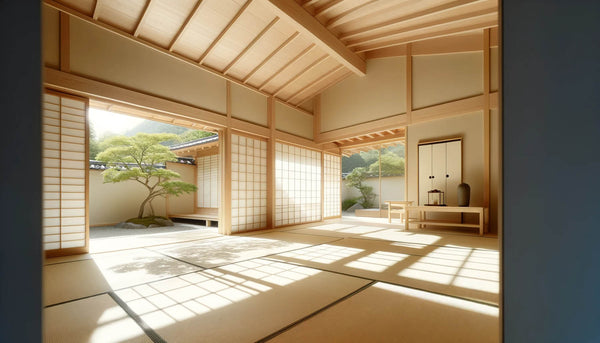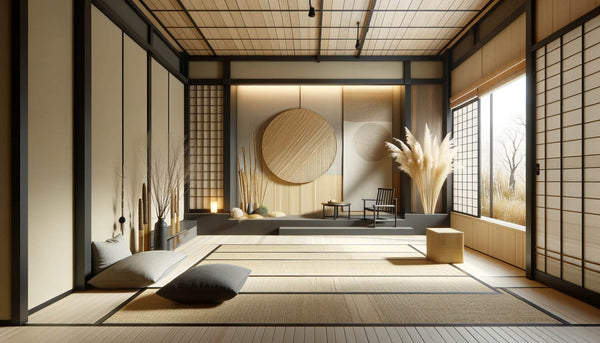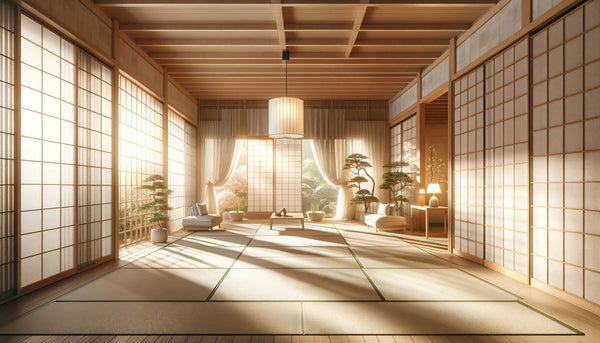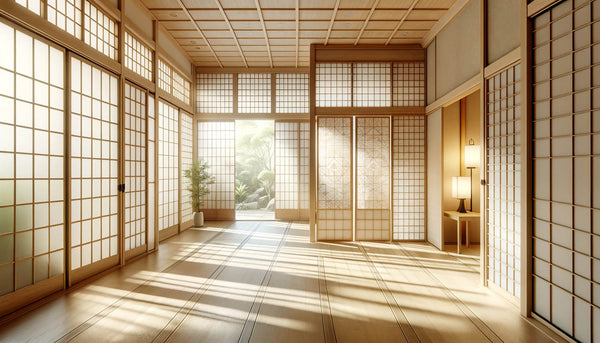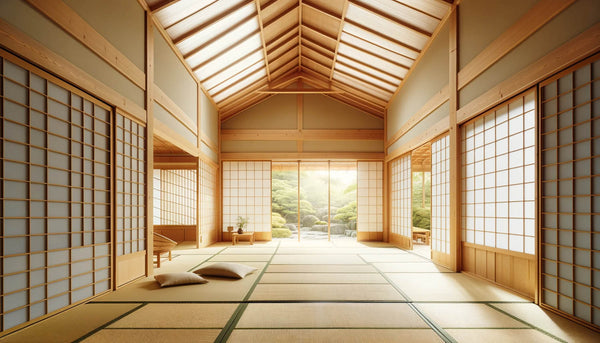Japanese interior design is challenging to define but easier to describe. The first thing to know is how it fuses both traditional Japanese design and modern principles of design. However, Japanese interior design also incorporates numerous other styles and elements that make it difficult to integrate into a simple definition. Nevertheless, this blog will organize the principles that are common features of Japanese interior design and help you select the right Japanese Furniture to fit your space and understand the purposes:
Japanese Design Principle 1: Flexibility
Efficient use of resources is a fundamental part of Japanese culture. Japanese rooms are typically multi-functional rooms that maximize space. For example, Japanese futon beds are folded and stored in the morning allowing the sleeping area to be reused during the day. Japanese room layouts are often reconfigurable. For example, Japanese interior walls may be composed of shoji screens that can be rolled back to join rooms. This ability to re-partition rooms for different uses during the day is essential in Japan where a highly urbanized society puts space at a premium.
This image illustrates the efficient use of space in Japanese rooms. The design highlights the multifunctional aspect of Japanese interiors, featuring Japanese futon beds and shoji screens, which emphasize the resourceful and reconfigurable nature of these living spaces. This image encapsulates the essence of maximizing space in a highly urbanized society like Japan, where room adaptability and efficient use of resources are paramount.
Japanese Design Principle 2: Privacy
Japanese society and culture values privacy and seclusion. Traditional Japanese interiors incorporate features such as paper screens (shoji) that allow light into a room while offering privacy for activities like prayer or meditation or intimate social activities.
This image illustrates the concept of privacy in traditional Japanese interiors, as described in the paragraph. The room includes traditional paper screens, or shoji, which are quintessential in Japanese design for providing privacy while allowing light to permeate the space. This setting is ideal for activities like prayer, meditation, or intimate social gatherings, showcasing how traditional Japanese design balances privacy with openness and light.
Japanese Design Principle 3: Natural Materials
Both traditional and modern Japanese interiors incorporate natural materials such as fine woods, bamboo, silk, rice straw mats and paper. The addition of interior plants and exterior landscaping will add others dimension of natural elements and deepen the experience.
We capture the essence of "Natural Materials" in the image above. The room beautifully showcases the use of natural materials such as fine woods, bamboo, silk, rice straw mats, and paper, which are integral to both traditional and modern Japanese interiors. The addition of interior plants and a view of exterior landscaping adds another dimension of natural elements, enriching the overall experience of harmonious and organic design.
Japanese Design Principle 4: Simplicity
Because Japanese culture values simplicity, and the space in any room is just as important as the design of a room and its contents. Rooms that are designed with a Japanese style always have an uncluttered appearance and are always decorated sparingly.
The Simplicity image vividly illustrates the concept of simplicity in Japanese interior design. The room is designed with an emphasis on uncluttered space and minimal decoration, perfectly capturing the Japanese cultural value of simplicity. The sparse yet thoughtful decor and the importance of open space in the room exemplify the elegance and tranquility of the Japanese aesthetic.
Japanese Design Principle 5: Subdued colors
Japanese interior design often uses the natural colors of materials such as wood, bamboo, paper and rice straw, instead of relying on stains or paints. When ‘unnatural’ objects or colors are incorporated, they tend to be subdued neutral palettes, including blacks, off-whites, grays and browns.
This concept room emphasizes the natural hues of materials like wood, bamboo, paper, and rice straw, complemented by a palette of subdued neutral colors such as blacks, off-whites, grays, and browns. This image showcases how Japanese design often relies on the inherent beauty of natural materials, creating a serene and balanced environment.
Japanese Design Principle 6: Diffused light
Japanese design generally uses diffused lighting techniques, which apply natural sources of light that penetrate interior rooms through translucent shoji screens. To achieve a sense of balance, sources of artificial light are diffused with natural materials, such as paper and natural fibers.
The room in this concept image features translucent shoji screens, allowing natural light to softly penetrate the interior. Additionally, artificial light sources in the room are diffused with natural materials like paper and fibers, creating a harmonious and balanced ambiance that is both serene and inviting.
Japanese Design Principle 7: Traditional Japanese Interior Design Elements
Japanese design is also characterized by the use of certain traditional elements that are still popular in any modern room designed with a Japanese style
Fusuma(襖)
Fusuma are Japanese sliding panels that are typically made of wood and paper or cloth. Although they’re sometimes referred to as sliding-doors, they’re often used across an entire wall, which allows adjacent rooms to be joined in flexible ways. Traditionally, Fusuma were painted by hand.
 Shoji (書院)
Shoji (書院)
Shoji are Japanese screens made with a wood frame and panes of translucent paper. Shoji screens are used as windows, doors and room dividers. Like Fusuma panels, they provide flexibility in room configurations. While Shoji allow natural diffused light into rooms, they also provide privacy.
Tatami(畳)
Tatami are traditional Japanese floors made of rice straw mats. In the past, most Japanese floors were tatami. In modern Japan, apartments and houses with one or two tatami rooms continue to be popular. Tatami are a standard size of 88cm x 176cm in Tokyo but the standard size varies by region.
Tokonoma (床の間)
A Tokonoma is an alcove that is used in reception rooms, such as tea ceremony rooms. Many modern Japanese living rooms still feature a Tokonoma, and it is always the focal point of any room. To complement this design, the room usually includes a simple display of Japanese artwork, such as a painting, a Japanese flower arrangement (ikebana) or calligraphy.
Embracing Harmony: The Essence of Japanese Interior Design
As we conclude our exploration of the principles of Japanese interior design, it becomes evident that the essence of this style is not just in its aesthetic appeal, but in its profound ability to create harmony and balance. Japanese design is a thoughtful orchestration of space, light, materials, and cultural elements, all coming together to form environments that are as serene as they are functional.
The principles we’ve discussed - flexibility, privacy, natural materials, simplicity, subdued colors, diffused light, and the integration of traditional elements like Fusuma, Shoji, Tatami, and Tokonoma - are not just design choices. They are reflections of a deeper cultural appreciation for nature, mindfulness, and the art of living well. In a world that often values excess, Japanese interior design stands as a testament to the beauty of restraint and the elegance of purposeful design.
As we integrate these principles into our spaces, whether through Japanese furniture selections or interior layouts, we're not just decorating our homes; we're inviting a piece of Japanese philosophy into our daily lives. This approach to interior design encourages us to pause, reflect, and appreciate the simple, natural beauty that surrounds us.
In your journey to incorporate these elements into your own space, remember that the goal is to create an atmosphere that resonates with tranquility and peace. Each element should contribute to a sense of harmony and balance, reflecting the uniquely Japanese understanding that true beauty lies in simplicity and serenity.
Thank you for joining us in this exploration of Japanese interior design. We hope it inspires you to create spaces that are not only visually stunning but also deeply connected to the values of harmony, simplicity, and mindfulness.
Updated 11/30/2023 - Miko Tanaka, Haiku Designs




